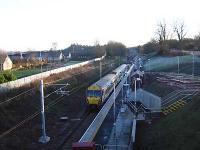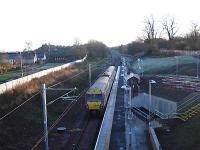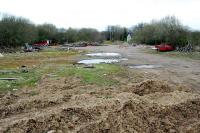Lesmahagow Railway
Introduction
This line is closed except for two short sections; - part of the Hamilton Circle. This section runs between Motherwell (Lesmahagow Junction) and Ferniegair (Ross Junction). - the Larkhall Branch. The section from Ross Junction to Merryton re-opened as the Larkhall Branch in 2005. Authorised as the Lesmahagow Branches. Also known as the Coalburn branch. The line ran south from Motherwell to Larkhall, Stonehaven, Blackwood, Lesmahagow and Coalburn.
Dates
Portions of line and locations
This line is divided into a number of portions.
Motherwell to Bankend
This is a junction just north of Motherwell station.
...
See also
Clydesdale Junction Railway
Motherwell Deviation Line (Caledonian Railway)
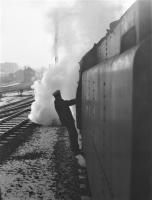
Robin McGregor 03/01/1967
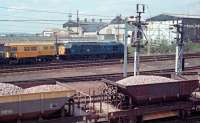
Ewan Crawford //1988
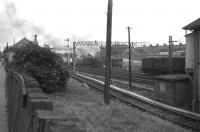
John Robin 05/07/1964
This is a four platform station. The station is at the junction of the Glasgow Central to London Euston main line and the Hamilton Circle line to Hamilton Central. There are carriage sidings on the west side of the station, next to the northbound platform of the Hamilton Circle lines.
...
See also
Clydesdale Junction Railway

John Yellowlees 30/05/2023

John Yellowlees 30/05/2023
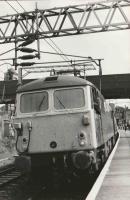
Crinan Dunbar /08/1982
This signal box was located south of the Hamilton platforms at Motherwell station. It was built at the site of the former Motherwell Bridge station.
...
This station was located just to the south of the present Hamilton platforms of Motherwell station.
...
This is a modern and minimal two platform station in the south of Motherwell. The station opened in a deep cutting to the south of Airbles Road.
...

David Panton 11/12/2019

John Furnevel 14/08/2006
This junction was to the south of Airbles station. Two colliery lines met the Lesmahagow Railway, one on either side of the main line. Approach to the mineral lines was from the north.
...
Owned by the Glasgow Iron and Steel co Ltd. Locate at the end of a branch which ran south east from Camp Colliery Junction.
...
This is a double track viaduct over the River Clyde, also known as Ferniegair Viaduct. The original 1856 single track viaduct began to fail around 1862 and was replaced. For many years the line carried considerable coal traffic, today it is on the Hamilton Circle line.
...

Ewan Crawford //1999

Network Rail /03/2023
This junction opened in 1876 between the 1856 Lesmahagow Railway and a new line west through Haughhead Junction to Hamilton Central and Hamilton West. This opening created the Hamilton Circle (actually teardrop shaped).
...
See also
Hamilton to Ferniegair (Caledonian Railway)
This colliery was sunk by Merry and Cunninghame in the 1860s. It was served by a short mineral line from Ross Juncion (the first part of this junction to be built).
...
This box was at the south end of the main part of Ross Yard, just south of where the Haughhead Junction to Ferniegair Junction line passed underneath. The box controlled access to the south end of yard.
...
This through station opened in 1868, replacing the Ferniegair [1st] terminus station, which was located a little to the south. Its opening coincided with the replacement of Camps Viaduct and the approval to run passenger trains between Lesmahagow Junction and the replaced Ferniegair [1st] station.
...
This station was a terminus for the line south to Lesmahagow [1st]. The line had opened to goods and minerals in 1856. Although the line continued north over the Camps Viaduct to Motherwell when the line opened to passengers in 1866 it was not passed for passenger trains requiring the terminus until replacement of the viaduct in 1868.
...
This is a new (2005) single platform station on a single track line, located on the west side of the line. The station has a large car park. To the south is the Allanton Loop.
...
See also
Hamilton to Ferniegair (Caledonian Railway)
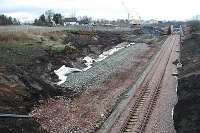
Ewan Crawford 27/3/2005
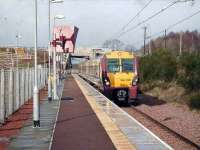
David Panton 08/03/2008
This junction was formed in 1876 when the 1856 Lesmahagow Railway was met by the a new Hamilton to Ferniegair (Caledonian Railway) line, an extension of the Hamilton branch which also created the Hamilton Circle. Ferniegair was the southern junction of a triangular junction.
...
See also
Hamilton to Ferniegair (Caledonian Railway)

Ewan Crawford 20/03/2005
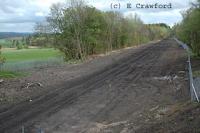
Ewan Crawford 2/5/2004
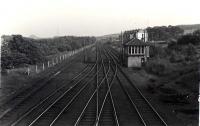
G H Robin collection by courtesy of the Mitchell Library, Glasgow 12/07/1962
This was a two platform station located directly south of Ferniegair Junction, the junction signal box being at the north end of the station's northbound platform. The station building was on the northbound platform with a shelter on the southbound.
...

Ewan Crawford 12/12/2005
This signal box was on the west of the line south of today's Chatelherault station and Allanton Loop.
...
This junction was north of Merryton station, (a new station dating from 2005).
...
See also
Mid Lanark Lines (Caledonian Railway)
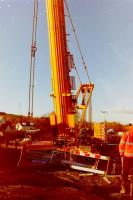
Gordon Steel /03/2005
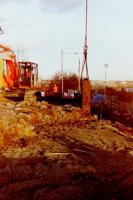
Gordon Steel /03/2005

Gordon Steel /03/2005
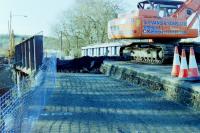
Gordon Steel /03/2005
This signal box was south east of Merryton Junction on the Lesmahagow Railway. It controlled access to Bog Colliery Pits Nos 1, 2 and 3, to the east, and Dykehead Colliery to the south.
...
This small signal box controlled a trailing crossover at a water tank between Larkhall East and Dykehead Signal Box. Both box and tank were on the west side of the line at the Daisy Cottages (east side).
...
This was a two platform station to the north east of Larkhall. The main station building was on the northbound line with a waiting room on the southbound.
...

Ewan Crawford 10/06/2005

John Robin 29/03/1964

Andy Carr Collection 29/03/1964
North of Dalserf station Millburn Colliery and Millburn Chemical Works were on a loop on the west side side of the line. The signal box was on the west side at the south end of the loop.
...
This was a two platform station. To the immediate south was Stonehouse Junction.
...
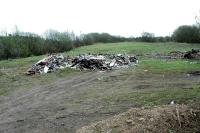
Ewan Crawford 10/06/2005

John Robin 29/03/1964

John Robin 29/03/1964
This was the branch between the line to Lesmahagow [1st] and the branch to Stonehouse [Lanarkshire]. This junction was directly south of Dalserf station, to the extent that the station goods yard led off the Stonehouse branch. (Later modified to be accessible via a headshunt laid on the west side of the branch which started at the station.)
...
This signal box was on the west side of the line at the north end of a loop off the main line which served Auldton Colliery. The colliery was on the east side. The north end of this loop was what is now Ashgill and south at Over Dalserf.
...
This signal box was on the east side of the railway controlling access to Over Dalserf Colliery.
...
This signal box was on the west side of the railway controlling access to Woodside Colliery Pit No 3.
...
This box, along with the nearby Hill Colliery Signal Box to the south, was associated with several mines to the north of Netherburn station.
...
This signal box was north of Netherburn station. The railway was double track. It was located on the east side of the line opposite a short mineral branch which ran north west to Hill Colliery from a reversing spur which made a trailing connection. From south of the box a long loop ran north, going behind the box, to serve Longlee Colliery No 3 Pit which rejoined the main line at ...
More detailsThis was a two platform station with small buildings and a footbridge at the south end. The station did not open with the line which was originally single track but progressively doubled (line opened 1856 and station 1866).
...

Ewan Crawford 27/3/2005
This location was, and is, an isolated spot. There were several sidings here serving the end of a long tramway running east to coal mines around Craignethan, north and east of Craignethan Castle itself.
...
This was a two platform station opened just to the north of Southfield Junction. The station served a countryside location with some coal mine and Craignethan Castle. ...
More details
John Furnevel 08/03/2007
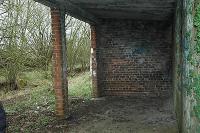
Ewan Crawford 27/03/2005

John Furnevel 08/03/2007

Ewan Crawford 27/03/2005
This junction was south of Tillietudlem station. It was the junction between the main line of the Lesmahagow Railway south to Lesmahagow [1st] and the branch south west to Blackwood [1st].
...

Ewan Crawford //
This was was located south of Tillietudlem station at the south end of a mineral line loop which began north of the station. The loop was on the east side of the station and also served the gas works.
...
This was a 12 span single track girder viaduct over the River Nethan. Known as 'The Big Brig'.
...

Ewan Crawford 27/03/2005

Ewan Crawford 27/03/2005

Ewan Crawford 27/03/2005

Ewan Crawford //
North of Auchenheath station, and immediately south of the Nethan Viaduct, the Little Gill mineral branch left the railway to run north (passing Auchenheath Colliery) then east (passing Auchenheath New Pit) and finally south to reach Little Gill Colliery.
...
This station did not open with the line, which opened in 1856. The site was just under a mile south of the Nethan Viaduct and close to Auchenheath House. The line was perched above the house.
...
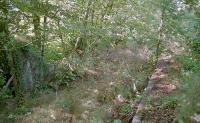
Ewan Crawford //1996

Ewan Crawford 10/11/2004
This was a single platform station. The station was south of a level crossing. It was a short platform. Opposite, on the east side of the line, was the signal box. It opened in 1891.
...
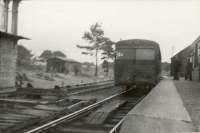
G H Robin collection by courtesy of the Mitchell Library, Glasgow 11/08/1949
This unadvertised halt was located at Alton Heights Junction. ...
More detailsThis was a four way junction. The location was originally called Auldton Heights.
...
See also
Mid Lanark Lines (Caledonian Railway)
Muirkirk and Lesmahagow Junction Railway
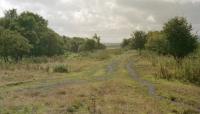
Ewan Crawford //1996
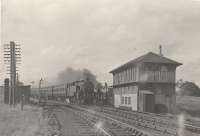
G H Robin collection by courtesy of the Mitchell Library, Glasgow 25/07/1953
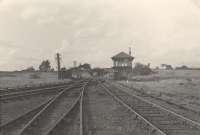
G H Robin collection by courtesy of the Mitchell Library, Glasgow 25/07/1953
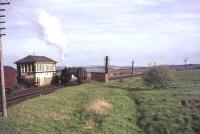
John Robin 15/05/1964
(Alternative closure date of 1957.) This halt served the nearby Auchlochan mines. Auchlochan Signal Box opened in 1891. The nearby Auchlochan Nos 6 and 7 Collieries and Auchlochan Nos 9 and 10 Collieries opened in 1894. The box opened to allow passenger trains to reach Coalburn, prior to its opening this was a goods and minerals only line, passenger trains terminated at [[Lesmahagow ...
More details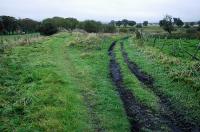
Ewan Crawford 27/09/2004
This halt served Bellfield Colliery No 3 and Bellfield Colliery No 4. ...
More detailsCoalburn station was opened on a line already open since 1856. Passenger trains had terminated further north at Lesmahagow [1st] until 1891 when the service extended south.
...
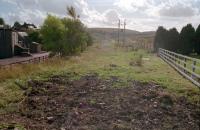
Ewan Crawford //1996

...
Douglas Blades /07/1967
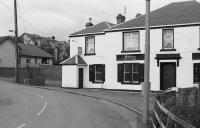
...
Bill Roberton //1990

...
Bill Roberton //1990
Bankend was the terminus of the Lesmahagow Branch. The line terminated in an area of coal mines. Mines were redeveloped several times with the line and associated tramways being altered as required. At its height there was a considerable number of sidings here.
...
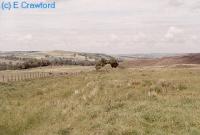
Ewan Crawford //

G H Robin collection by courtesy of the Mitchell Library, Glasgow 25/06/1953
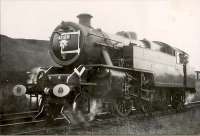
G H Robin collection by courtesy of the Mitchell Library, Glasgow 11/08/1949
Stonehouse Branch
This was the branch between the line to Lesmahagow [1st] and the branch to Stonehouse [Lanarkshire]. This junction was directly south of Dalserf station, to the extent that the station goods yard led off the Stonehouse branch. (Later modified to be accessible via a headshunt laid on the west side of the branch which started at the station.)
...
This junction was for initially for Swinhill Colliery. The junction probably opened with the line. Both the spellings Swinehill and Swinhill were used. The signal box used the spelling Swinehill.
...

John Robin 29/03/1964
Served by private mineral line running from Canderside Exchange Sidings.
...
See also
Canderigg Colliery Branch (James Nimmo and Co Ltd)
This was a double track masonry arch viaduct, only carrying one track, built over the Cander Water. On the site of the bridge is a road bridge carrying the A71.
...
This junction was east of Stonehouse [Lanarkshire] station. The 1864 Stonehouse branch of the Lesmahagow Railway was met by the Merryton Junction to Stonehouse section of the 1905 Mid Lanark Lines (Caledonian Railway).
...
See also
Mid Lanark Lines (Caledonian Railway)
This was a large station of four platforms where four lines met. It had begun as a much smaller station with one platform.
...

David Panton 12/09/1960

Gordon Steel //1913

Ewan Crawford 18/07/2015

John Robin 15/05/1964
This junction was west of Stonehouse [Lanarkshire]. It was created when the original Lesmahagow Railway branch to Stonehouse of 1864 was met with two sections of the 1905 Mid Lanark Lines (Caledonian Railway). The original route east to Dalserf and the route west through Stonehouse to Cot Castle Goods survived.
...
See also
Mid Lanark Lines (Caledonian Railway)
This goods station was the terminus of a branch from Stonehouse Junction. It was to the east of the ruins of Cot Castle [Castle]. The station was simple, terminating in a pair of long sidings (probably a loop), with a short siding on the south side by the access road.
...
See also
Mid Lanark Lines (Caledonian Railway)
Blackwood Branch
This junction was south of Tillietudlem station. It was the junction between the main line of the Lesmahagow Railway south to Lesmahagow [1st] and the branch south west to Blackwood [1st].
...

Ewan Crawford //
This signal box was roughly half way between Southfield Junction and Blackwood [1st].
...

Ewan Crawford 27/03/2005
This junction opened in 1905 when the 1864 Blackwood [1st] branch (passengers from 1866) of the Lesmahagow Railway was met by two sections of the new Mid Lanark Lines (Caledonian Railway).
...
See also
Mid Lanark Lines (Caledonian Railway)

G H Robin collection by courtesy of the Mitchell Library, Glasgow 30/06/1953
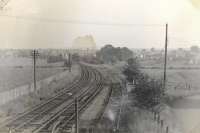
G H Robin collection by courtesy of the Mitchell Library, Glasgow 30/06/1953
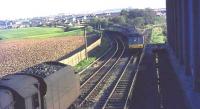
John Robin 15/05/1964
This station was the terminus of a branch from Southfield Junction. Tram roads served the area, from 1856, before the branch fully opened from Southfield Old Pit to Blackwood in 1862.
...
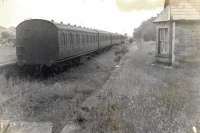
G H Robin collection by courtesy of the Mitchell Library, Glasgow 30/06/1953
This was a set of sidings at Dunduff Quarry, a whinstone quarry. The layout changed as the quarry enlarged with new rock crushers and tramways being laid as required. The sidings were at the south end of the Dunduff Branch.
...
Swinhill Branch
This junction was for initially for Swinhill Colliery. The junction probably opened with the line. Both the spellings Swinehill and Swinhill were used. The signal box used the spelling Swinehill.
...

John Robin 29/03/1964
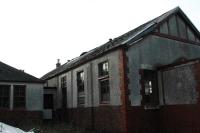
Ewan Crawford //
Little Gill Branch
North of Auchenheath station, and immediately south of the Nethan Viaduct, the Little Gill mineral branch left the railway to run north (passing Auchenheath Colliery) then east (passing Auchenheath New Pit) and finally south to reach Little Gill Colliery.
...














